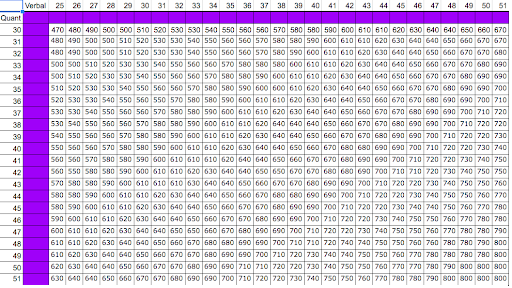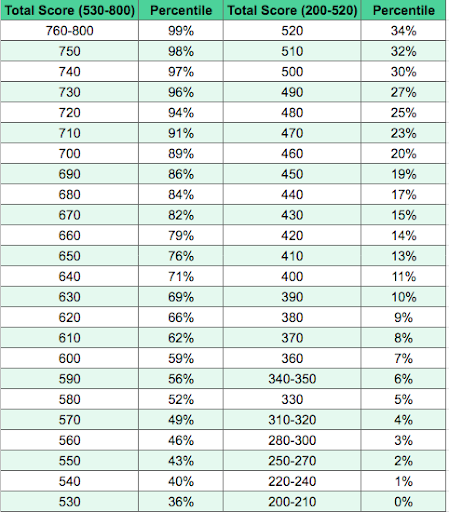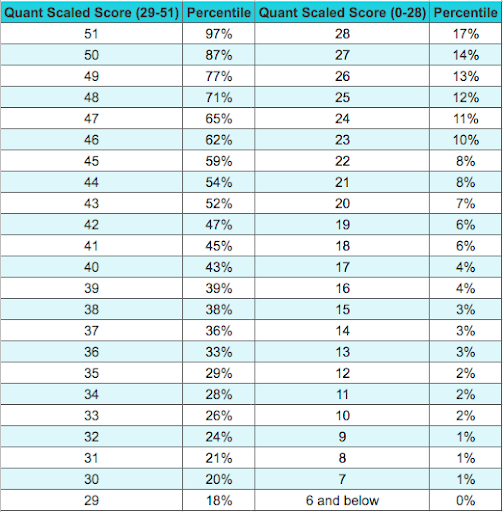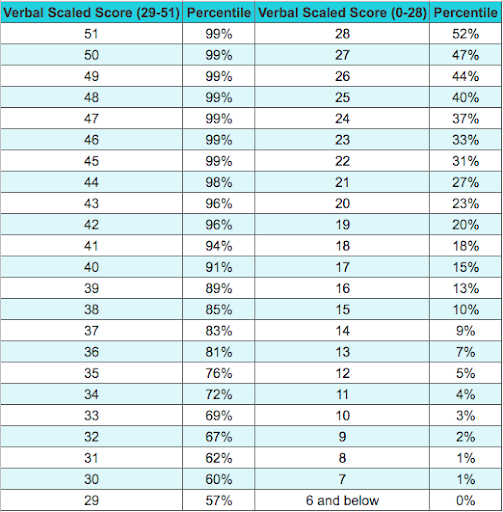The GMAT test is competitive – but what does that mean for you, as a test-taker?
As a GMAT test-taker, you cannot fail to evaluate GMAT Score Chart because the GMAT is competitive. You get a certain score, which can be anywhere between 200 and 800.
Here’s the fun part:
If you deliberately answer every question wrong, you will still get a 200 on the GMAT. There’s no such thing as ‘failing’!
But you probably already knew that… You probably also know that you can get a score that is pretty much the equivalent of failing. If you don’t know or understand how percentiles work, you will have trouble figuring out how to evaluate your performance on the GMAT.
If you have just done a practice test and are trying to figure out whether you’re ready to take the actual GMAT test, you’re in the right place.
In fact, you’re in the right place even if you’ve just taken the test and are sitting with your raw scores trying to figure out how to calculate your GMAT composite score.
(Also, for the uninitiated – the final GMAT score is called the GMAT composite score.)
So, this article is going to help you address all of the following:
How did I do on the GMAT?
So, first things first – how do you figure out whether your GMAT test score is good or bad?
It’s both simple and a little bit complicated, depending on how well-versed you are with percentiles and GMAT score charts. But let’s break down the GMAT scoring mechanism and understand what we’re dealing with first.
Your GMAT result typically consists of four scores corresponding to the four sections of the GMAT test – Analytical Writing Assessment (AWA), Integrated Reasoning (IR), Quantitative Reasoning (Quant), and Verbal Reasoning (Verbal).
The GMAT is designed to function on an adaptive scoring algorithm. This algorithm puts your raw scores together and computes a final score which isn’t simply an addition of the parts.
In fact, the scales for these parts and the composite score are totally different.
GMAT AWA scores range from 1 to 5, IR from 0 to 8, and neither of these affects your final score since both these scores are not included in that calculation. This does not mean AWA and IR scores don’t matter. They do. They’re just not included in your final GMAT score, that’s all. Your Quant and Verbal scores can range between 6 and 51 each.
But your final GMAT test score falls between 200 and 800.
If you’d like to understand more about how this scoring mechanism works, you can read our blog about the GMAT scoring algorithm.
Even if you score a 750, it holds no value in isolation.
You will need a score chart to make sense of your GMAT composite score because your performance won’t be considered stellar if a lot of people have also scored 750. For the same reason, you’ll need a score chart to make sense of your Quant and Verbal scores, too.
A GMAT score chart gives you a sense of where you stand in comparison to everyone else who took the exam over the three years immediately before you took the exam yourself.
To get this, you will need to have your individual and composite GMAT scores. This conveniently brings us to the next section of this article.
How to calculate your GMAT score
There are many mock GMAT tests available on the internet. None of them will be good enough to help you figure out what your real GMAT score will look like.
As mentioned before, the GMAC uses a very specific adaptive algorithm to administer real GMAT tests. What this means is rather simple – there are experimental questions strewn throughout your test and your answer to each question determines the difficulty level of the next question you’re asked. The marks for each answer depend on the difficulty level of the question.
You cannot see the level of the questions you’re answering, so you honestly have no way of knowing what score to expect while taking the exam.
If you have taken any of the official mock tests available on MBA.com, you will know this feeling. You breeze through an entire test and feel like you did really damn well, but then you get a super disappointing score and you cannot figure out why.
Blame that algorithm.
To get a GMAT score that is close to accurate, you need to take an official mock test.
There is no unofficial mock test on the internet that can simulate the way the actual GMAT works. So, if you have scores from any of the unofficial tests, rest assured that there will be a significant difference between those and what you’ll get on official tests.
We know that MBA.com only offers a limited number of tests, so we are not recommending that you only take official mock GMAT tests.
Feel free to take as many mock tests as you like. Just make sure you don’t rely on the scores you may get on any of those unless they’re official mock tests.
You won’t need to go through this first step if you took the official mock GMAT because you’ll receive your composite score along with the break-up at the end of an official mock test.
If you only have your raw GMAT Verbal and GMAT Quantitative scores, this step is for you. Use the following chart to find what your composite score may look like.
To reiterate – this score is not entirely reliable. However, it will do for now.
The scores you calculate in this manner are only a rough indication of where you may stand. Your composite score on the actual GMAT test can vary by +/- 40 or 50 points from what you’re getting through this chart.
This doesn’t mean that you will get a different composite score for the same Quant and Verbal raw scores.
Your raw scores themselves are likely to be drastically different when you’re taking the actual GMAT or even the official mock tests. That’s why we recommend that you take the official mock tests available on MBA.com and rely only on those scores.
The official mock tests available on the GMAC website make use of the same algorithm that is used in the actual GMAT.
This means the scores you get from these tests are the closest and most accurate representations of what you can expect to get when you take the actual GMAT test. That’s what makes them reliable scores.
However, mba.com only provides a finite number of mock tests, which means you need to use these tests sparingly.
In any case, now that you have your composite and sectional scores, let’s move on to discussing a few interesting facts about GMAT scoring on official mocks.
GMAT Scoring on Official Mock Tests
There are a couple of things about the official mock tests that puzzle many GMAT test takers:
Is the highest Verbal and Quant score 60 or 51?
Can you score higher than 51 in GMAT Verbal and Quant?
Why is the scale up to 60 if you can’t score more than 51?!
Admittedly, all these are pertinent questions. But here’s the thing:
You need to focus on what matters to you, so there’s no point getting into the nitty-gritty of everything. What you need to know is that the highest possible score on Verbal and Quant is 51 each.
Even if you answer every single question correctly in both sections, your score will not cross 51 in either one of the sections.
Most of all, if you get a Q51 V51 score, your GMAT composite score will be 800.
For curiosity’s sake, though, let’s consider for a moment the nine points between 51 and 60, even though we know it’s impossible to score these points.
A large number of test-takers are now scoring higher on the GMAT than before. The GMAC, the authority that conducts the GMAT, has offered a set of explanations as to why that is happening, but in any case, the GMAC will most likely have to take steps to pull down the average score.
The general speculation is that if using the current scale (highest score being 51) becomes too top-heavy, meaning if too many people consistently score higher on the GMAT test, the GMAC may open the range up from 51 and allow Quant and Verbal scores up to 60 each.
However, this is only speculation. While it is good to stay informed, it’s important not to let this information cloud your judgment.
As long as the scoring system remains the way it currently is in 2021, your target score need not change.
Rising Percentiles and GMAT Scoring
You may have seen that the scale of scores for GMAT Verbal and Quant are 0-60 for both, yet nobody can score above 51. So, what’s the point of having 9 unattainable points?!
Here’s what:
GMAT percentiles are showing an upward trend. This means more and more test-takers are scoring 700+ on the GMAT, so the percentiles for scores 700 and above are rapidly rising.
The problem with this is simple.
The greater the number of people scoring above 700, the lesser the value of their scores becomes because the GMAT works on percentiles.
The GMAT is a competitive test meant to help B-Schools identify the crème-de-la-crème of the MBA aspirants who take the test. If everyone begins to score exceedingly well, it becomes problematic because the score is then no longer helping to narrow down the pool of applicants.
What the GMAC says about this is worth considering:
The Graduate Management Admission Council, which conducts the GMAT, has released a statement claiming that the rise in scores is not due to students performing better, but due to changes in the exam pattern.
At first, this doesn’t sound very logical – but bear with us.
The two changes in the exam pattern are the introduction of Select Section Order and Score Cancelling.
Here’s how that might be impacting GMAT scores:
The introduction of Section Order Selection enables test-takers to change the way they approach the exam entirely. As a test-taker, you can now choose which section to attempt first. Most test-takers attempt the easier sections first and leave a larger chunk of time to tackle the remainder of the exam.
Naturally, this has test-takers performing better – not because they’re getting better at answering the questions asked, but because they’re able to structure their exam in a way that they prefer to take it.
This implies that a 760 scorer may not score a 760 if they were to take the test according to the old pattern of IR & AWA > Verbal > Quant.
Doesn’t that seem logical? Sure does, to us!
Unfortunately, though, this explanation doesn’t help one bit. It still leaves us with the fact that scores are going up and percentiles are on the rise.
It is not possible to identify those who scored better only due to Section Order Selection and separate them from those who would’ve scored what they did irrespective of the order of sections.
The second factor that the GMAC referred to is test-takers’ ability to self-cancel scores.
This explanation actually makes a lot of sense. What the GMAC says is this:
Test-takers now have the ability to cancel their scores, which inevitably leaves us with a collection of scores that are higher. The average of scores that is counted is no longer based on the scores of all GMAT tests taken because a vast majority of the lower end of scores is being canceled by test-takers around the world.
It’s no surprise then that we’re seeing the average score go up.
It isn’t because everyone is scoring better, it’s because those who score low marks are canceling their scores.
Now for the final part of understanding and using GMAT score charts- score comparison.
GMAT Score Chart – Percentiles
If you have your GMAT Composite Score, you can use the following chart to find out what percentile you fall in.
To find out your percentile ranking in the individual sections – Quant and Verbal – you can refer to the following two charts respectively.
Comparing Percentile Scores
It is lost on many Indian test-takers that you cannot compare your scores across exams simply because you’re considering percentiles.
The percentile system does not work like percentages.
In fact, the differences between percentage and percentile are huge.
When you say you have scored 90% marks, what you mean is that you got 90% out of the sum total marks that were available. The picture is entirely different when you say you are in the 90th percentile.
Percentile is not an indication of your score at all. It is an indication of the competitive value of your score. This means that your percentile rank is calculated based on how many test-takers have scored the same as or worse than you.
So, when you have scored 90%, it may or may not be a big deal based on whether other people have scored similar marks. However, when you stand in the 90th percentile, you know for certain than 90% of the other test-takers have scored less than or equal to you.
The first lesson here is never to compare percentage against percentile; they’re worlds apart.
Now even if you’re comparing percentile against percentile, there’s a bunch of factors to consider.
First among these factors is the audience of the test.
For example, you cannot compare a global exam to a national exam, like the GMAT and the CAT.
This is the most common mistake people make when comparing GMAT vs CAT scores:
People assume that the percentiles on the GMAT and CAT are comparable when they cannot be so, by definition. This is because the set of competitors your score is compared against in the GMAT is global, whereas in the CAT it is national.
Being in the 80th percentile for GMAT verbal is not the same as being in the 80th percentile on CAT verbal. On the GMAT, your percentile shows your score in comparison to the entire world. On the CAT, your score is only compared to that of other Indians. Why do Top MBA Programs require High GMAT Scores?
Clearly, a higher percentile on the GMAT is significantly more valuable than the same percentile on the CAT.
So, the lesson to learn from this is that scores cannot be compared simply because they’re in percentile form. Multiple parameters that go into the calculation of these scores should be comparable for the score comparison to make sense.





